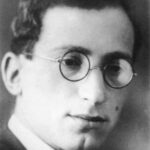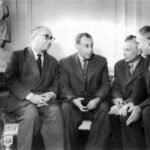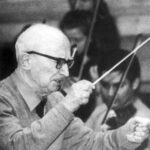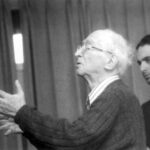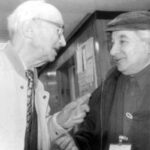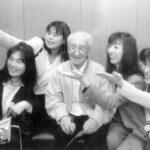“A conductor must make music visible to his musicians with his hands. There are two components to conducting, expressiveness and exactness. However these two components are incompatible; in fact, they cancel each other out. The conductor’s challenge, therefore, is to find a way of combining them.”
Ilya Alexandrovich Musin (1903-1999) was a legendary conducting teacher and pedagogue who taught at the Saint Petersburg Conservatory, formerly the Leningrad Conservatory of Music, for over 60 years. He devoted his life to exploring the art of conducting and to developing a scientific approach to the craft, educating generations of conductors. Among the students he taught include Yuri Temirkanov, Semyon Bychkov, Valery Gergiev, Mariss Jansons, Tugan Sokhiev, Teodor Currentzis, Vassily Sinaisky, Sian Edwards and Martyn Brabbins.
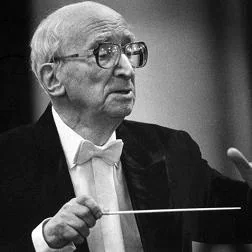
Born in the ancient town of Kostroma, on the banks of the Volga, during the Romanov dynasty, Musin entered the Saint Petersburg Conservatory two years after the Russian Revolution of 1917. “The first person I met at the conservatory was Mitya Shostakovich and we became friends”. “Mitya” was of course the thirteen year old Dmitri Shostakovich who had enrolled in the conservatory on the same day and was in the same class as Musin. As classmates, they exchanged ideas about music. Musin would often play through sketches of the composer’s latest works on the piano and was one of the first people to hear his First Symphony, playing through the first and second movements on piano together with Shostakovich himself.

Musin studied conducting under Nikolai Malko and Aleksandr Gauk, becoming one of Malko’s star pupils and assistant. He began teaching shortly after graduating and developed a comprehensive theoretical system to enable the student to communicate with the orchestra with the hands, requiring minimal verbal instruction. Much of his approach derived from natural motion and body language, which he supplemented with more formal theories taken from the writings of the acting teacher Konstantin Stanislavsky.
This painstaking study of the art of gesture and its influence on orchestral colour and sound would become the basis of the St Petersburg/Leningrad School of conducting for the next 60 years. He played a major role in the development of conducting as a true profession with a thorough method and system for learning. Ilya Musin died in 1999, teaching at the conservatory until just three days before he died.
Musin’s books
Musin wrote four books, three of them about conducting technique. His books contain priceless advice and information for conductors in every stage of their development. They are extremely detailed, yet comprehensible and easy to follow.
- Conducting Technique (1967) – Техника дирижирования
- The Education of a Conductor (1987) – О воспитании дирижера
- Lessons of life (1995) – Уроки жизни
- The Language of the Conductor’s Gesture (2007) – Язык дирижёрского жеста
His treatises “Conducting Technique” (1967) and “On the Education of the Conductor” (1987) acquired wide popularity among conducting teachers, students and performers. They include exercises, diagrams, symphonic and operatic extracts, and in-depth analyses of the conductor’s movements and gestures. His focus was always on non-verbal communication – how to show, not tell, the orchestra what and how to play, and that technique is always at the service of the music. His ideas on technique teach how to create different kinds of articulations, phrasing, dynamics, tempi, colour, musical character, left and right hand independence, and much more.
His memoirs, “Lessons of Life”, published in 1995, is a fascinating read which is unfortunately still only available in Russian. However some of the articles linked to above use this book as a source of information and quote from it.
In his last book, “The Language of the Conductor’s Gesture” he unravels the art of conducting, which he researched for decades as pedagogue and performer. His scientific, analytical approach enabled him to develop and communicate a profound understanding of the conductor’s craft. The book deals with the fundamental questions of pedagogy, starting with first assignments and leading to the development of a specific gestural language to influence performers in rehearsal and concert. It is available in an English translation by Daniel Boico from Sfera Publishing.
Further reading
Musin lived a long and eventful life which spanned major events of the 1900’s. There are some well written articles available in English which give a good insight into Musin and his life.
One of the most interesting is Brenda Leach’s wonderful article written for the Journal of the Conductors Guild in 2004 which you can read HERE.
There is a well-researched dissertation by Scott Elliott Woodard which focuses not only on Musin the pedagogue but also on his life. Read it HERE.
Other articles worth reading are his obituaries in The Guardian and The New York Times, as well as an article in The Independent written when he had his British debut (at the age of 92!).
There are a number of interesting articles written about Musin in Russian. Translations of some of them will be available here soon.
Conducting lessons and other video material in English
There are many videos of Musin teaching his class in St Petersburg available on YouTube. A good place to start is the Conductor Training channel, which has many short clips available of Musin discussing and showing specific conducting techniques with explanations in English in the description.
Also available are two videos of Musin teaching which are dubbed into English. Filmed not long before his death, they are of great importance. Part 1 is Musin explaining his school of technique, and Part 2 shows him teaching in various masterclasses.
And finally here is a fascinating interview by Vassily Sinaisky, with subitles in English, about Musin which also shows him conducting and teaching.

